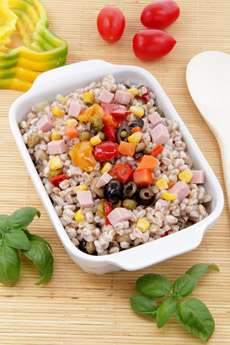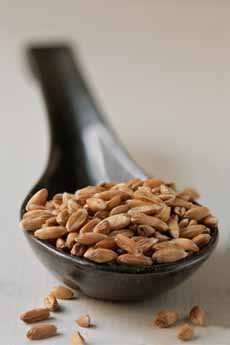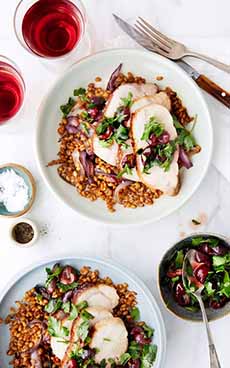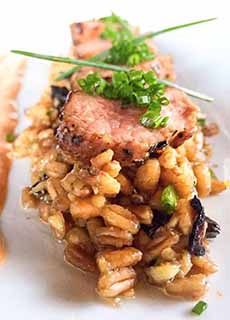TIP OF THE DAY: Try Farro, a.k.a. Emmer Wheat, A More Nutritious Type Of Wheat
|
Farro is the original wheat, one of the first cereals domesticated in the Fertile Crescent. It nurtured the population of the Mediterranean and Middle East for thousands of years. It was cultivated by the ancient Egyptians; it became the staple ration of the Roman Legions; it was ground to create the original polenta. It has a mildly nutty flavor; a firm, chewy texture; and is lighter in body than traditional grains such as rice and barley. Like arborio rice, farro releases a creamy liquid similar when cooked and can be used to make a [chewier] risotto. Because it was harder to grow and produced lower yields, farro, an unhybridized form of wheat, took a back seat to higher-yielding hybrids. Gourmet restaurants saved the farro crop—or rather, it was saved by the farmers of the French Haute Savoie region, who brought their product to the chefs. Always seeking something new to please their clientele, chefs embraced farro in soups, stews and sides. Their foodie clients wanted more, and the health-conscious discovered the nutrition of this whole grain. Today, you can find it at good supermarkets, specialty food stores and health food stores. And farro is more nutritious than modern wheat: Our featured recipe, Mediterranean Farro Bowl With Vegetables & Feta, follows, as does the history of farro. It’s easy to confuse farrow and spelt. Farro looks rather like spelt, another early species of wheat; but they are not the same. Farro is emmer wheat, the original wheat. The botanical name for both farro and emmer wheat is Triticum dicoccum. Spelt is Triticum spelta; the most common modern wheat is we eat is Triticum aestivum. To be sure you’re getting whole grain farro, look for “whole” or “whole grain” on the label. “Pearled” or semi-pearled farro, which is quicker cooking, is not whole grain and lacks the fiber and nutrition from the germ and bran of whole grains. Pearling removes the inedible hull that surrounds the grain, but the process also scours off part (semi-pearled) or all (pearled) of the nutritious germ and bran. Whole-grain farro is hulled using a gentler process that leaves the germ and bran intact. This recipe combines roasted eggplant, peppers and cherry tomatoes with farro and a red wine vinaigrette. It’s a perfect blend of tart and savory flavors. Loaded with fiber and protein, it’s a healthy lunch, an appetizer or a side dish. For those who prefer organic ingredients, DeLallo sells organic farro. 1. HEAT the oven to 425°F. Line 2 baking sheets with parchment paper. 2. COOK the farro according to package instructions. Set aside to cool, and place in large bowl. Meanwhile… 3. TOSS the eggplant and onion with 2 tablespoons of oil and 1 teaspoon of salt and place on one baking sheet. Roast for 20-25 minutes or until the eggplant is soft and golden brown. Remove from the oven and cool. 4. TOSS the tomatoes with 2 tablespoons of oil and 1 teaspoon of salt and place on the second baking sheet. Roast for 20-25 minutes or until the tomatoes are blistered. Remove from the oven and cool. 5. MAKE the dressing: Whisk together the feta, vinegar, mustard, oregano, salt and pepper. Once combined, continue to whisk in the oil in a slow and steady stream until the dressing emulsifies. 6. ADD the roasted vegetables and peppers to the farro. Drizzle the dressing over the mixture and toss well to combine. Garnish with mint and feta and serve. Today’s demands for better foods are bringing back some of the oldies, like farro. You can find: An unhybridized ancestor of modern wheat, farro was one of the first grains cultivated by man in the Fertile Crescent, also known as The Cradle Of Civilization. Here’s more on the earliest cultivated crops. Farro was a mainstay of the daily diet in ancient Rome, and it sustained the Roman legions as they conquered Europe. It was an important staple in parts of Europe from the Bronze Age to medieval times. So Why Did Farrow “Go Away?” Because the yields aren’t as high as with other wheat species. Over the millennia, the tastier and more nutritious strains of many crops were abandoned in favor of strains and hybrids that produced greater yields and were less resistant to weather fluctuations, diseases and pests. |
|
|
|
(This selective breeding process for grains and produce was also used to develop animal species: food animals, work animals and companion animals.) By the beginning of the 20th century, there were a just a few hundred acres under cultivation in remote areas of Italy, and little was grown elsewhere, except in Ethiopia (where emmer constitutes about 7% of the wheat crop). The growing interest in better-for-you foods has brought farro back. Thanks for that!
|
||







